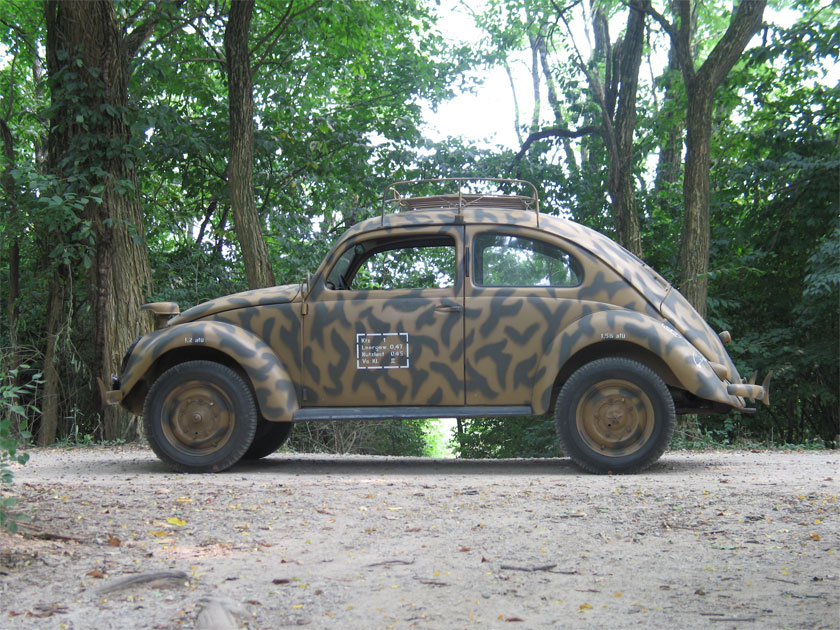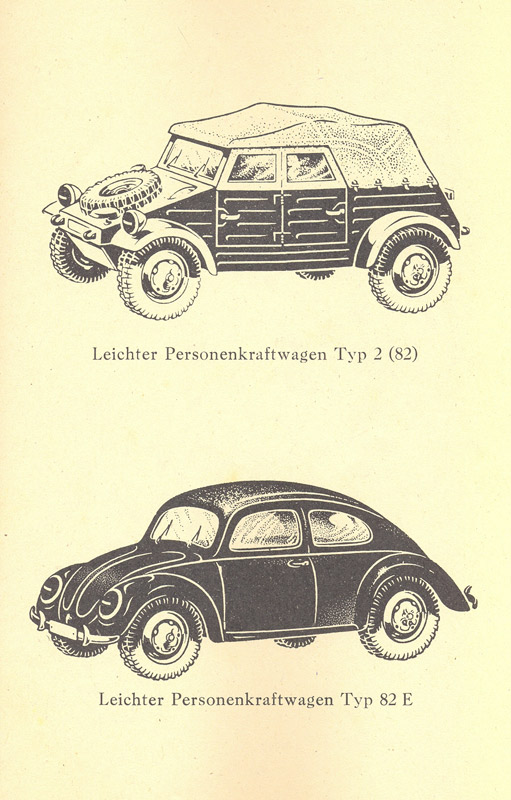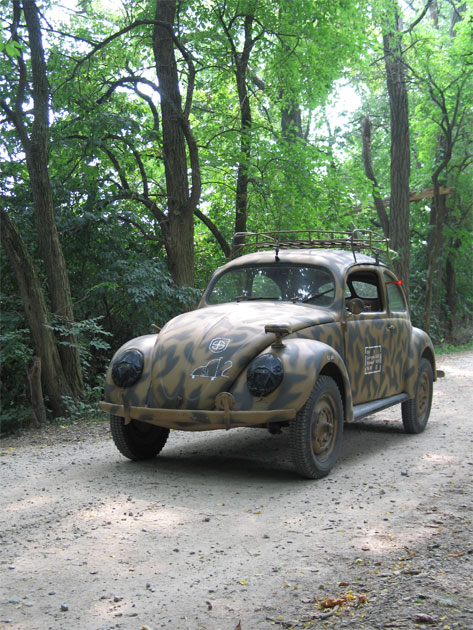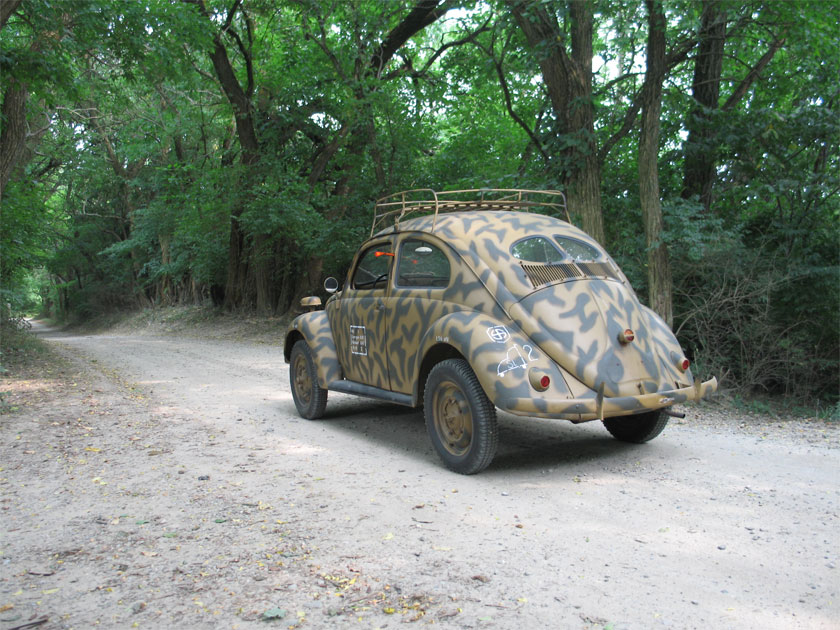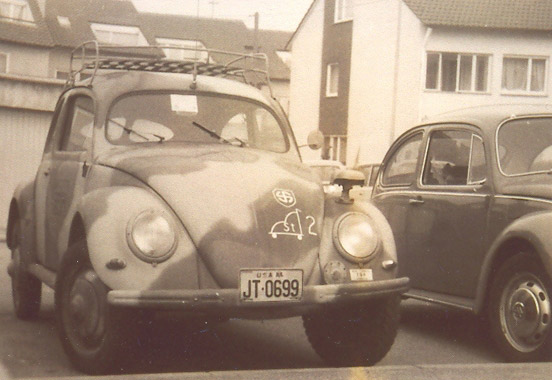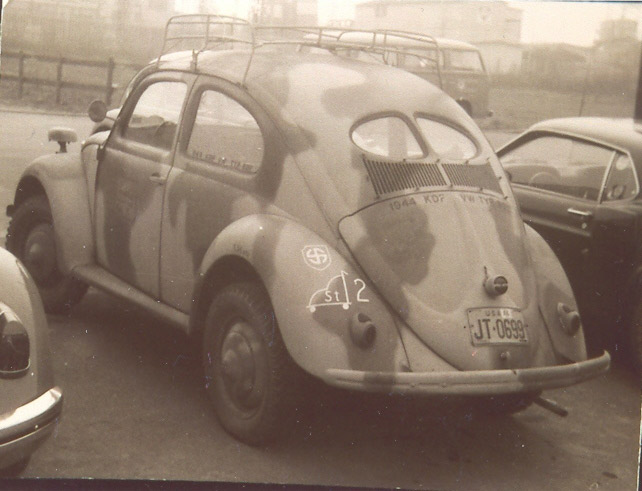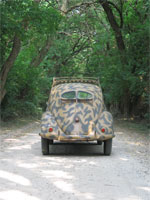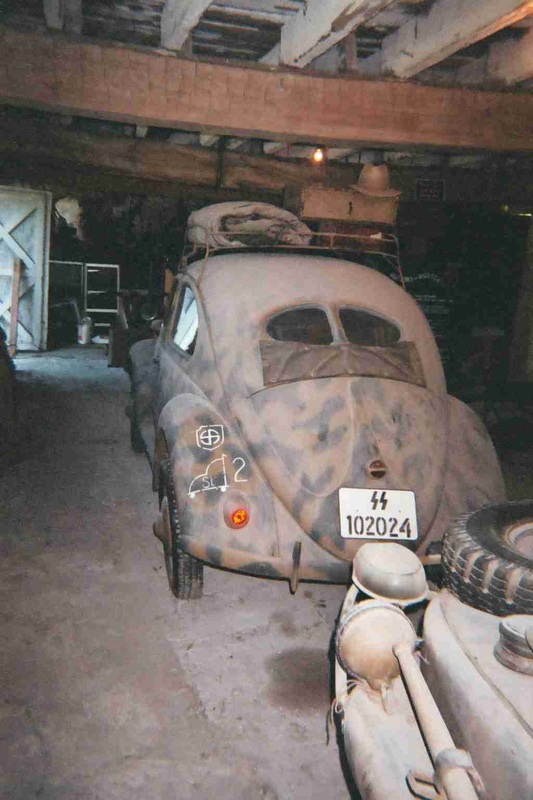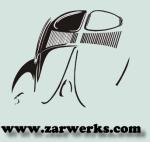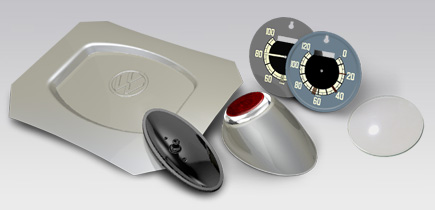1944 KDF 82E
|
The car that we know as the Volkswagen Beetle today began as the brainchild of Dr. Ferdinand Porsche. In the 1930’s he began working towards production of a practical automobile, which the average German could afford. He took some of his inspiration for the idea from Henry Ford’s Model T; a car which sold for as little as $500.00 by the 1920’s, and which was seen everywhere on America’s roads.
Porsche contracted with two different companies, one after the other, to produce his affordable car. The contract with Zundapp fell through due to the production costs of the car and their desire to concentrate on motorcycles. The contract with NSU came to an end when they noticed a contract with FIAT where NSU agreed to not produce automobiles. In the end Dr. Porsche founded his own design firm and on January 17, 1934 he published his “Expose”. The Expose discussed the concept of a practical affordable car for the people. This caught the eye of the German government and shortly after Dr. Porsche found himself in a meeting with the Chancellor, Adolf Hitler. Hitler had his own ideas for a people’s car. The years following this meeting would be a time of development and compromise as Dr. Porsche’s team worked with government support on creating the car we know as the “Beetle”. There were several series of cars tested through the mid to late 1930’s. The series had such names as the V1, V2, V3 and VW 30. By the time of the factory cornerstone laying in 1938 the basic Beetle had come into being. This car had lost its Tatra-esque rear louvers in trade for a rear window, and had gained such amenities as running boards and forward hinged doors. Mechanical changes are too numerous to discuss here. |
Hitler surprised the project team by renaming their Volkswagen at the factory cornerstone laying. He renamed it the “KDFwagen”. The KDF initials translate into “Strength-Through-Joy”. The government created a savings program for the German people. The average person could purchase a savings book in which they could purchase a five Reichmark stamp each week. A few hundred thousand Germans enrolled in this program.
On September 1st, 1939 Germany invaded Poland and WWII began. The stamp savers would never receive their cars or their money back. Very few KDF type 60’s (the Beetle’s new designation) were produced during WWII, and those that were went to high-ranking Nazi party members. The VW plant bosses handed the plant over to the government in 1939 so as to speed up production on facilities but compromising to allow the production of other war materials at the plant. During the war production ranged from vehicles to stoves to V-1 rockets.
On September 1st, 1939 Germany invaded Poland and WWII began. The stamp savers would never receive their cars or their money back. Very few KDF type 60’s (the Beetle’s new designation) were produced during WWII, and those that were went to high-ranking Nazi party members. The VW plant bosses handed the plant over to the government in 1939 so as to speed up production on facilities but compromising to allow the production of other war materials at the plant. During the war production ranged from vehicles to stoves to V-1 rockets.
|
Production began at the plant on the military type 82 (Kubelwagen) between May and August of 1940. Ambi Budd produced the bodies for these Spartan vehicles and delivered them to the factory. There the bodies were mated to a KDF chassis similar to the basic type 60 chassis. The Kubelwagens had lower gearing and rode higher. Around 50,000 were produced during the war.
The type 82E (also known as the type 92 and postwar as the type 51) was the mating of a type 60 body to a type 82 chassis. The result was an off road Beetle. These vehicles appear under various designations. One 82E was a prototype body mounted onto a handy 82 chassis. Another was mistakenly listed in papers as a pickup. Two 82E’s were specially produced for a Berlin to Kabul Afghanistan run. These 82E’s had extra ventilation, fans, blinds for sleeping and more. They had roof racks and were loaded front tall smallwith everything from tools and spares to camping gear and a short wave radio. The two 82E’s and occasional companion type 82 made their way from Berlin May 27, 1941 and arrived in Kabul on June 26. They never made the return trip home as Allied forces had moved into Iran. The cars were probably destroyed to keep them from falling into enemy hands. |
|
There are very few other records of 82E’s. As for their use they seem to be mainly heavy-duty staff cars. One that resides in the United States was used by Herman Goering’s staff office in Paris. Another survivor in Europe served on a border patrol.
(All sources for this article are listed in the Info. and sources section. I must especially recommend Chris Barber’s Birth Of The Beetle for early VW fans. Another great source for this article was Terry Shuler’s Volkswagen: Then Now and Forever. Other information was gathered first hand or from a variety of articles and tidbits in other books.) |
Our KDF's History
|
When I received this car I knew nothing about its history other than it took an award at the Military Max show in the early 1990’s. I was also told a wildly erroneous story about its background. The Erroneous story went as follows,” originally assigned to the SS Nordland Division as a staff car it was found in the Templhof district of Berlin 1945 covered with boards as protection from the bombing and the rubble. Located by Captain Connors US Army of Occupation it became his personal car while stationed in Berlin…” this twaddle goes on to describe how the car somehow maintained its original paint through all of this etc. etc. Well, the Canadian museum selling this from their storage had no provenance to back this up, so I set out to find the true story behind this car.
|
The truth:
Through extensive research, tracking and contacting former owners, and assistance from other early VW enthusiasts I have managed to gather quite an amount of provenance on this car. To begin with, Mr. Connors would have to have been a wildly precocious four year old to have found the car in Berlin circa 1945. He was born in 1941. I also found that many of the museum’s other claims were false as well. Overall this was a learning experience in making sure that anyone making claims about a vehicle has the paperwork to back them up.
Through extensive research, tracking and contacting former owners, and assistance from other early VW enthusiasts I have managed to gather quite an amount of provenance on this car. To begin with, Mr. Connors would have to have been a wildly precocious four year old to have found the car in Berlin circa 1945. He was born in 1941. I also found that many of the museum’s other claims were false as well. Overall this was a learning experience in making sure that anyone making claims about a vehicle has the paperwork to back them up.
Mr. Connors provided me with a great deal of information about the car. My 1944 KDF 82E was delivered to the German Military acceptance point in Koblenz in 1944. The Waffen SS and the Home Land Defense Forces received most of their vehicles through this distribution point. Mr. Connors discovered the car heavily damaged amongst many other wartime VW’s in an Austrian junkyard in 1964. (Sadly, in the early 1970’s he went back to purchase whatever was left in the junkyard only to find everything had been crushed.) The car was smashed in the left side and the rear window had been made into an oval. The metal glove boxes were rusted out as well. He traded a five-gallon can of U.S. Army OD green paint to the junkyard owner for the car.
The car was restored using parts from a 1947 Beetle, and it appears that portions of a 1952 body were used as well (remember, this was 1964 and the battered wartime VW's were only going for about $50.00 at the time). The delivery marking on the driver side door was copied from the original marking that was found after removing a layer of paint from the car. Mr. Connors painted the car using original German WWII paint he found in Stuttgart. The car received SS Wiking division markings, as many of the other WWII vehicles in the junkyard were Wiking division. Mr. Connors had two uncles in the armored section of the SS Wiking division and thus the further designation on the car in their honor. The radio in the car was obtained by trading the original KDF block plate to a fellow in Belgium. The roofrack came from another Beetle in the Austrian junkyard. (Another neat tidbit: when I was in communication with Mr. Connors he asked me if there was still a spare parts list in the glove box. He had obtained one back in the 1960's and had kept it with the car. I was happy to inform him that every owner since had held onto that Ersatzteilliste and that the car arrived with it in the driver's side glovebox.)
Mr. Connors had several other wartime VW’s. This car served as his daily driver while he was stationed in Germany. He described driving it between Luxemburg and Vienna regularly. One time, when trapped in a heavy snowstorm, he managed to dig the car out and drive it in the ruts of German army trucks while all other cars were still stuck.
The car was restored using parts from a 1947 Beetle, and it appears that portions of a 1952 body were used as well (remember, this was 1964 and the battered wartime VW's were only going for about $50.00 at the time). The delivery marking on the driver side door was copied from the original marking that was found after removing a layer of paint from the car. Mr. Connors painted the car using original German WWII paint he found in Stuttgart. The car received SS Wiking division markings, as many of the other WWII vehicles in the junkyard were Wiking division. Mr. Connors had two uncles in the armored section of the SS Wiking division and thus the further designation on the car in their honor. The radio in the car was obtained by trading the original KDF block plate to a fellow in Belgium. The roofrack came from another Beetle in the Austrian junkyard. (Another neat tidbit: when I was in communication with Mr. Connors he asked me if there was still a spare parts list in the glove box. He had obtained one back in the 1960's and had kept it with the car. I was happy to inform him that every owner since had held onto that Ersatzteilliste and that the car arrived with it in the driver's side glovebox.)
Mr. Connors had several other wartime VW’s. This car served as his daily driver while he was stationed in Germany. He described driving it between Luxemburg and Vienna regularly. One time, when trapped in a heavy snowstorm, he managed to dig the car out and drive it in the ruts of German army trucks while all other cars were still stuck.
|
The car appeared in March of 1976 in an article by Chris Barber (the black and white photos are from that article). This article was written for the small club magazine "Beetling". Mr. Barber notes that this was back in the days before much of the early history of VW was known so such articles are somewhat inaccurate. Shortly after that Mr. Connors sold the VW to a fellow from Long Island.
Mr.Kennedy Ward had met Mr. Connors in Germany and had ridden in the car prior to its sale. Mr. Ward eventually placed an advertisement with a picture of the car in Hemmings. He offered to buy the car if anyone knew where it was. A man who had purchased the car from the Long Islander contacted Mr. Ward shortly after the ad was listed. The new owner was a Mr. Lloyd in Connecticut and he wanted to sell, partially because he could not get the car to shift gears. Mr. Ward bought the car and soon called in Mr. Connors to help him get it going again. The now stateside Mr. Connors found that someone had filled all the gearboxes with automatic transmission oil. Once that was changed out everything ran smoothly again. |
|
Mr. Ward wrote an article about the 82E for the spring 1980 issue of Army Motors. (Many thanks to the MVPA staffers who helped me find the article!) One funny tidbit included in the article involves the radio. Mr. Ward wrote,” When I first got it I told my two youngsters that since it was a German vehicle that the radio would only play in German. It is a short wave radio, and when I turned it on, the first thing we heard was someone speaking in German. My surprise was almost as great as theirs!”
By the 1980's the vehicle was in rough shape from daily use, the paint was deteriorating, and with more research being done on these cars some parts were noticeably incorrect. The vehicle received its current paint job from either Mr. Ward or the Canadian Military Studies Museum. During this restoration many of the incorrect parts from the original restoration were replaced. Note the change to correct bumpers among other things. Mr. Ward sold the car to the Canadian Military Studies Museum in 1987. The vehicle was shown at the MAX militaria show in the early 1990's by Mr. Grant, a member in the CMSM. At the MAX show the car took either Best of Show, or Most Historically Significent. (Special thanks to MAX show staff for this information.)
|
The future for this car consists of rebuilding a wartime KDF engine for it, and slowly going through and addressing deterioration issues and authenticity issues which can be corrected while remaining true to this vehicle's convoluted history. As of August, 2006 I took the vehicle for its debut at the Kubel Korps reunion in Camden, Ohio. I drove the 82E all over the encampment that the Kubel Korps rented, and even took it on an off-road night convoy. I was surprised at how well the car handled, and how well it ran after all my work. I am sure the car was happy to be among its wartime friends again. I even took a couple photos of the 82E parked next to a Kubelwagen which Kennedy Ward had owned. The Kubel Korps folks are wonderful, and the group is well worth joining if you have a wartime KDF vehicle, be it Schwimmwagen, Kubelwagen or other. The members, and especially David Crompton, have been extremely helpful with our work on this car.
A final note, sadly Mr. Ward passed away in 1999. He apparently really loved the car and I will maintain it and enjoy it with him in mind.
(Special thanks to the many many people of the early Volkswagen community who helped us track the history of this car. We cannot express how much your help meant to us.)
A final note, sadly Mr. Ward passed away in 1999. He apparently really loved the car and I will maintain it and enjoy it with him in mind.
(Special thanks to the many many people of the early Volkswagen community who helped us track the history of this car. We cannot express how much your help meant to us.)
Info. and parts sources (scroll down for websites and parts links)
Books:
Birth of the Beetle. By Chris Barber
ISBN# 1-85960-959-7
(This book is a must for all who are interested in the early development of VW and then Porsche)
VW Beetle at War. By Dr. Hans-Georg Mayer
ISBN# 0-88740-400-6
Volkswagen Militarfahrzeuge 1938-1948. By Dr. Hans-Georg Mayer-Stein
ISBN# 3-7909-0488-0
Volkswagen Beetle: The Rise From the Ashes of War. By Simon Parkinson
ISBN#1-874105-47-2
Volkswagen: Then Now and Forever. By Terry Shuler
ISBN# 0-929758-12-9
Birth of the Beetle. By Chris Barber
ISBN# 1-85960-959-7
(This book is a must for all who are interested in the early development of VW and then Porsche)
VW Beetle at War. By Dr. Hans-Georg Mayer
ISBN# 0-88740-400-6
Volkswagen Militarfahrzeuge 1938-1948. By Dr. Hans-Georg Mayer-Stein
ISBN# 3-7909-0488-0
Volkswagen Beetle: The Rise From the Ashes of War. By Simon Parkinson
ISBN#1-874105-47-2
Volkswagen: Then Now and Forever. By Terry Shuler
ISBN# 0-929758-12-9
Informative Websites:
This site has some excellent detail pictures of an 82E.
WWII VW website.
http://www.vwbroukklub.cz/autosalon/brom/brom.htm
I believe this is a Czech site on restoring an 82E/87
www.VW166.com
an informative site about Schwimmwagens.
Many great articles, and a wartime VW forum.
www.vvwca.com
Vintage Volkswagen Club of America
www.kubelwagen.co.uk
Great website for information and parts.
www.willeweb.de/vvwbba/main/main.php
A wide variety of VW information.
I believe this is a Czech site on restoring an 82E/87
www.VW166.com
an informative site about Schwimmwagens.
Many great articles, and a wartime VW forum.
www.vvwca.com
Vintage Volkswagen Club of America
www.kubelwagen.co.uk
Great website for information and parts.
www.willeweb.de/vvwbba/main/main.php
A wide variety of VW information.
Parts
Bob at BBT helped me when I was looking for parts for the 82E. He is very
knowledgeable and a joy to do business with. I could not recommend BBT more.
knowledgeable and a joy to do business with. I could not recommend BBT more.
Parts for split beetles.
Reproduction parts and restoration services for early Beetles. These fellows are
regular contributors to early Beetle elists.
regular contributors to early Beetle elists.
Split 49. They reproduce parts for splits from early 1949 back.
Vintage Parts Inc.
These folks carry parts for early Beetles and Kubelwagens.
dieter.krebernik.at/krebernik.php
Mr. Krebernik comes highly recommended, though I cannot figure out his new website.
www.vvm.com/~histpart/motorcyclesmain.htm
Information and parts. Historical Parts and Militaria Co.
www.blitzbikes.com/id26.htm
Blitzbikes parts for Kubelwagens and Schwimmwagens.
Vintage Parts Inc.
These folks carry parts for early Beetles and Kubelwagens.
dieter.krebernik.at/krebernik.php
Mr. Krebernik comes highly recommended, though I cannot figure out his new website.
www.vvm.com/~histpart/motorcyclesmain.htm
Information and parts. Historical Parts and Militaria Co.
www.blitzbikes.com/id26.htm
Blitzbikes parts for Kubelwagens and Schwimmwagens.
